The Personal Scores of Paderewski
By Jeffrey Wagner
For the Polish Museum of America
October 2009
In his memoirs Paderewski reflected that it is easier to sit down and play the piano when the player’s own enjoyment is the primary goal. However, he wrote, “if [a pianist] wishes that other people have pleasure from his playing, he must work!” Paderewski, by his own admission, was a tireless self-disciplinarian. He felt that he was not a naturally gifted pianist, nor that he had great dexterity at the keyboard. Nevertheless, he became the foremost virtuoso of his era by dints of hard and painstaking work. He labored endlessly to keep his piano technique in concert form, while, at the same time, vowing never to use his piano technique in the service of pure showmanship. Paderewski respected the pianist’s craft, even the pianist’s ability to dazzle at times, but far more important to him were the higher artistic ideals served by that craft.
Paderewski’s own pupil and friend, Sigismond Stojowski, wrote, “Paderewski is the most careful and painstaking of teachers.” Of the performer’s art in general, and Paderewski’s in particular, Stojowski explains, “A great artist’s performance of a noble work ought to sound like a spontaneous improvisation; the greater the artist, the more completely will this result be obtained. In order to arrive at this result, however, the composition must be dissected in minutest detail.” Another pupil, Antoinette Szumowska, echoed Stojowski’s observations when she wrote, “He [Paderewski] takes infinite trouble to work out each detail and bring it to perfection.”
In the days when Paderewski traveled the USA in his personal, lavishly-appointed rail-car, he took an upright practice piano in the train with him. He was known to practice his programs at all hours in the railroad yards and stations of the cities in which he gave concerts. While it may seem paradoxical, it has nevertheless been thoroughly documented that the magical, theatrical, even charismatic atmosphere of a public Paderewski concert, was founded upon disciplined and devoted attention to the myriad details of the masterpieces he performed. His appearance of effortless performance stemmed directly, and only, from hard, intensive work.
Paderewski’s personal and annotated, copies of music by several of the masters he revered – notably Chopin, Schubert, and Beethoven -- are in a collection at The Polish Museum of America (PMA). Marked with his own fingerings and other markings, these copies provide a window into the great pianist’s private world of work at the keyboard. Bound in brown paper for added protection and annotated by Paderewski himself in pencil, these sometimes dog-eared musical scores yield to today’s viewer a glimpse of the everyday sort of work no pianist, even Paderewski, can avoid. In his possession at the time of his death in 1941 in New York, these scores were donated by Paderewski’s sister, Antonina Paderewska Wilkonska, to the PMA.
In this collection, there are the complete works in three volumes of his beloved compatriot, Fryderyk Chopin, in an edition published by Bote and Bock Company (Berlin). This 1880 edition was edited by Charles Klindworth, a well-known 19th C. German conductor and pianist. The volumes were personalized for Paderewski. His initials were embossed in gold on the gilded leather covers.
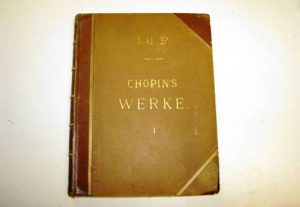
Gerald Moore, a famous vocal accompanist to numerous stars of his era, thought highly of Paderewski’s artistry and wrote perceptively of his musicianship. This is a strong endorsement, as Moore was universally respected for his tasteful musicianship. He wrote that while some critics had criticized Paderewski for slowing down in performance when difficult passages came along, one should not conclude that there was anything inadequate about Paderewski’s technique. “These ‘slowing downs’ ”, he observed, “were sometimes rhetorical. Paderewski was an accomplished orator and he imbued his playing with this quality.”
The Polish word, przedłuzyć, meaning “to extend” or “to elongate,” and penciled in Paderewski’s copy of Chopin’s Scherzo in C# Minor, brings Moore’s observation to mind. Paderewski very likely wanted to remind himself not to rush through this passage, as numerous virtuosos would do. Indeed, by elongating or drawing the tempo out a bit, he may well have heightened the sense of drama inherent in this passage. Or, as some musicians might say, Paderewski simply wanted to make sure that the music “spoke” clearly. Paderewski’s concern in performance was, above all, not to dazzle, but to communicate. Example 2:
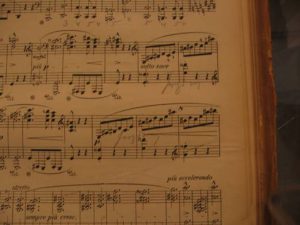
In a passage from Chopin’s Ballade in F Major, Paderewski carefully marked a somewhat unusual fingering in the left hand octaves in the lower left-hand corner, measures 1 and 2 of the lowest line. (Musical Score Example 002):
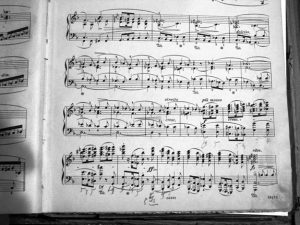
His fingering, while more difficult than a straightforward use of the fifth finger on each of the octaves, points the performer towards the making of a true legato sound, essential to the correct playing of Chopin. These fingerings are indicative of Paderewski’s devotion to the musical sound rather the ease of a dexterous virtuoso. Note also that Paderewski has lowered by an octave the left hand octaves (measures 2 and 3) to reinforce Chopin’s fortissimo (ff) marking. Such tasteful modifications were not unusual in the pianist’s era. In doing this Paderewski was only emphasizing Chopin’s wish for a full dramatic sound.
It is also interesting to note that Paderewski’s penciled fingerings in the opening measures of this Ballade differ from the recommended fingerings published in the edition of this work that bears his name, published years later. (The Paderewski edition was actually prepared by numerous Polish pianists and musicologists, and we therefore have no way of knowing if these fingerings were entered by Paderewski). In this edition, the editor indicated the repeated use of the third finger on the repeating melody notes on C. (Musical Score Example):
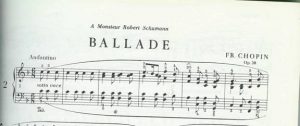
In his personal edition, Paderewski shows a preference for changing between the third and fourth finger on these repeated Cs. This fingering may help the player to achieve the ability to distinctly separate the Cs while still projecting a legato sound through the use of the neighboring third and fourth fingers.
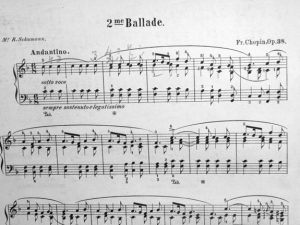
Paderewski’s tendency to “finger” octave passages, thereby enabling a legato sound, may be found in several other examples from the works of Chopin. In the passage shown below from Chopin’s Ballade in G Minor, he even indicates that he uses his third finger, as well as the fourth and fifth, on some octaves. (This also suggests that Paderewski’s hands, or his stretch, or both, were somewhat larger than average. (Musical Score Example 003):
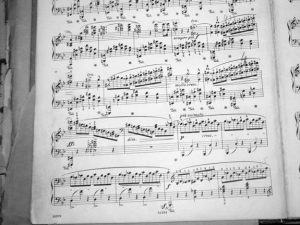
Similiar care to adopt fingerings that help to achieve a legato sound may be found in this passage from Chopin’s Etude in G# Minor (the fearsomely difficult “etude in thirds”). Paderewski carefully, almost lovingly, fingered not the frighteningly difficult thirds in the right hand, but the three-note chords in the left hand. Again, it is Paderewski, the musician, who stepped to the fore here, alongside the virtuoso. While the listener will inevitably focus on the player’s ability or inability to play the hair-raising chromatic thirds in the right hand, these fingerings remind us that music must also be made in the beautiful, slower, supporting chords of the left hand. (Musical Score Example 020):
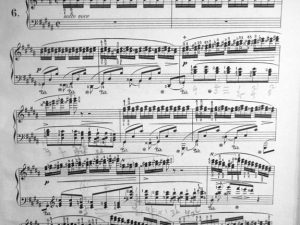
What we do not find in Paderewski’s scores are markings indicating his use of the piano’s pedal. This would have been most interesting, in light of the many comments about his artistic use of the pedal. An American Critic, Henry T. Finck, wrote, “No other pianist, except perhaps Chopin, has understood the art of the pedaling as Paderewski understands it.” We can only speculate that Paderewski may have felt that Klindworth’s printed suggestions for pedaling were sufficient. It is also likely that Paderewski, who certainly understood the many subtleties in the artistic use of the pedal, may have felt that the standard notational style – a clear-cut indication of either “on”or “off” – was simply not sufficiently precise. World-class artists use many gradations of pedaling (i.e. several different levels of pressure on the pedal by the foot), above and beyond the simple approach: “all the way down” or “no pedal at all.”
It is also fair to say that artists vary their touch at the keyboard, and their pedalings, depending upon the acoustics of the surroundings. Paderewski, who played in hundreds of major and minor concert halls, had an unrelenting wish to create a beautiful sound. He must have had to vary his touch and pedal frequently in the face of changing acoustical conditions. In other words, it is quite possible that a pedaling that worked in Carnegie Hall would not have been right, as he saw it, in the astonishingly fine and different acoustics of Chicago’s Auditorium Theater.
It is said that the English actor, Sir John Gielgud, would spend hours practicing a simple theatrical motion such as the removal of a handkerchief from his pocket, so that this gesture would seem utterly natural, indeed spontaneous, in performance. Much the same can be said of the pianist’s discipline. Repetition, analysis, details – these are the hidden (from the public) precursors to a performing artist’s journey into the higher realms on stage. The precious Paderewski scores in the collection of The Polish Museum of America testify eloquently to Paderewski’s devotion to his art. These scores give us yet another view of his humanity, in that they show unmistakably that he did not exempt himself from the hard and faithful work through which every true performer must undertake.
References:
- Moore, Gerald. Collected Memoirs (Penguin Books, 1986)
- Stevenson, Ronald. The Paderewski Paradox(The Klavar Music Foundation of Great Britain and La Société Paderewski, 1992)
- Paderewski, Ignace Jan and Mary Lawton. The Paderewski Memoirs (Charles Scribner’s Sons, 1938).
- Mirecki, Barbara and Krystyna Nowakowska. Catalogue of Paderewski’s Personal Scores at the Polish Museum of America.
